Exploring Leadership: Theories, Concepts, and Real-World Examples
VerifiedAdded on 2023/06/13
|8
|1961
|271
Report
AI Summary
This report provides an overview of leadership principles, highlighting the crucial role of leadership in organizational success. It discusses various leadership theories, including transformational, transactional, trait, situational, great man, contingency, and behavioral theories, providing examples of leaders like Jeff Bezos and Bill Gates and their application of these theories. The report emphasizes that effective leadership is essential for achieving a competitive advantage and ensuring long-term survival, advocating for the adoption of suitable leadership styles to motivate followers and promote organizational growth. The report concludes that the statement 'Everything rises and falls on leadership' is correct.
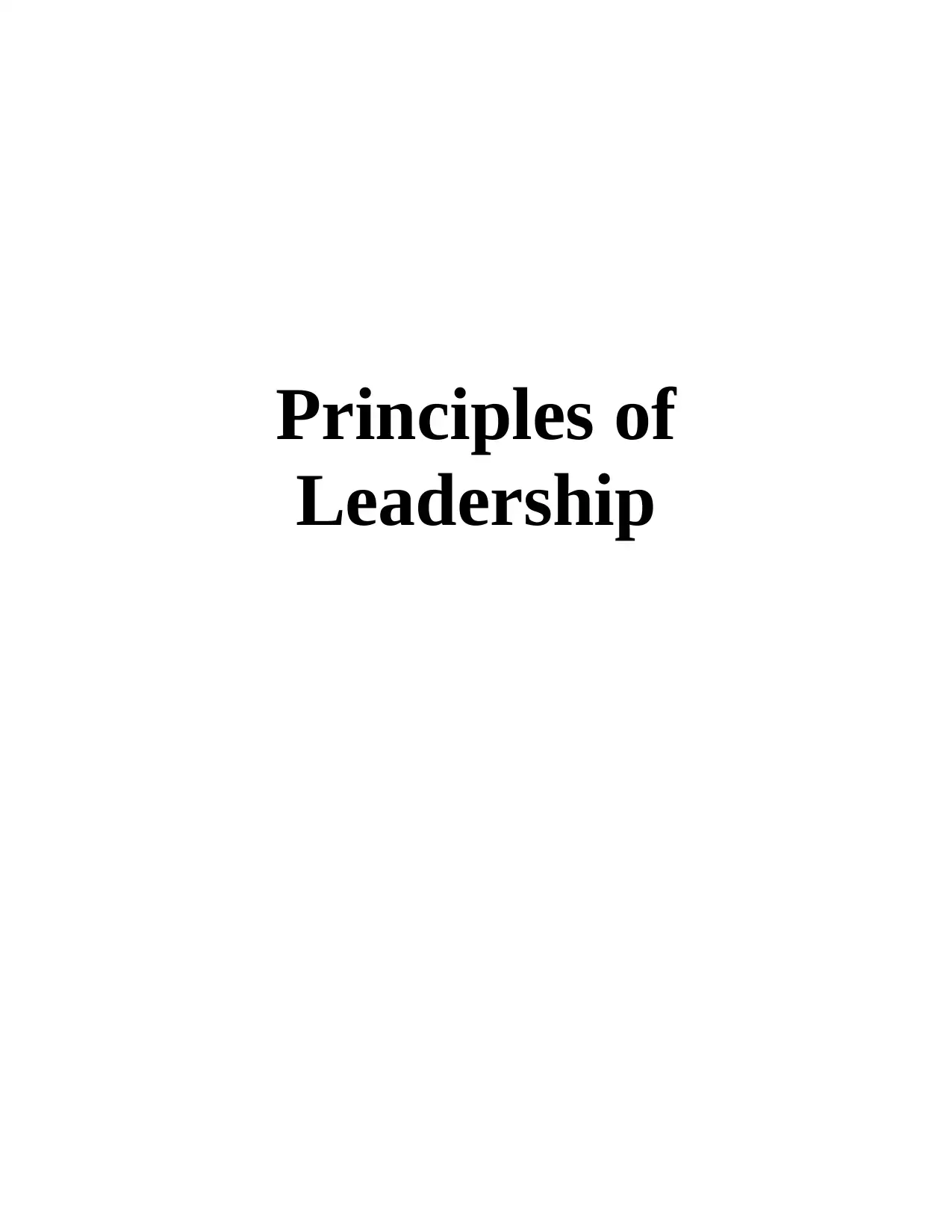
Principles of
Leadership
Leadership
Paraphrase This Document
Need a fresh take? Get an instant paraphrase of this document with our AI Paraphraser
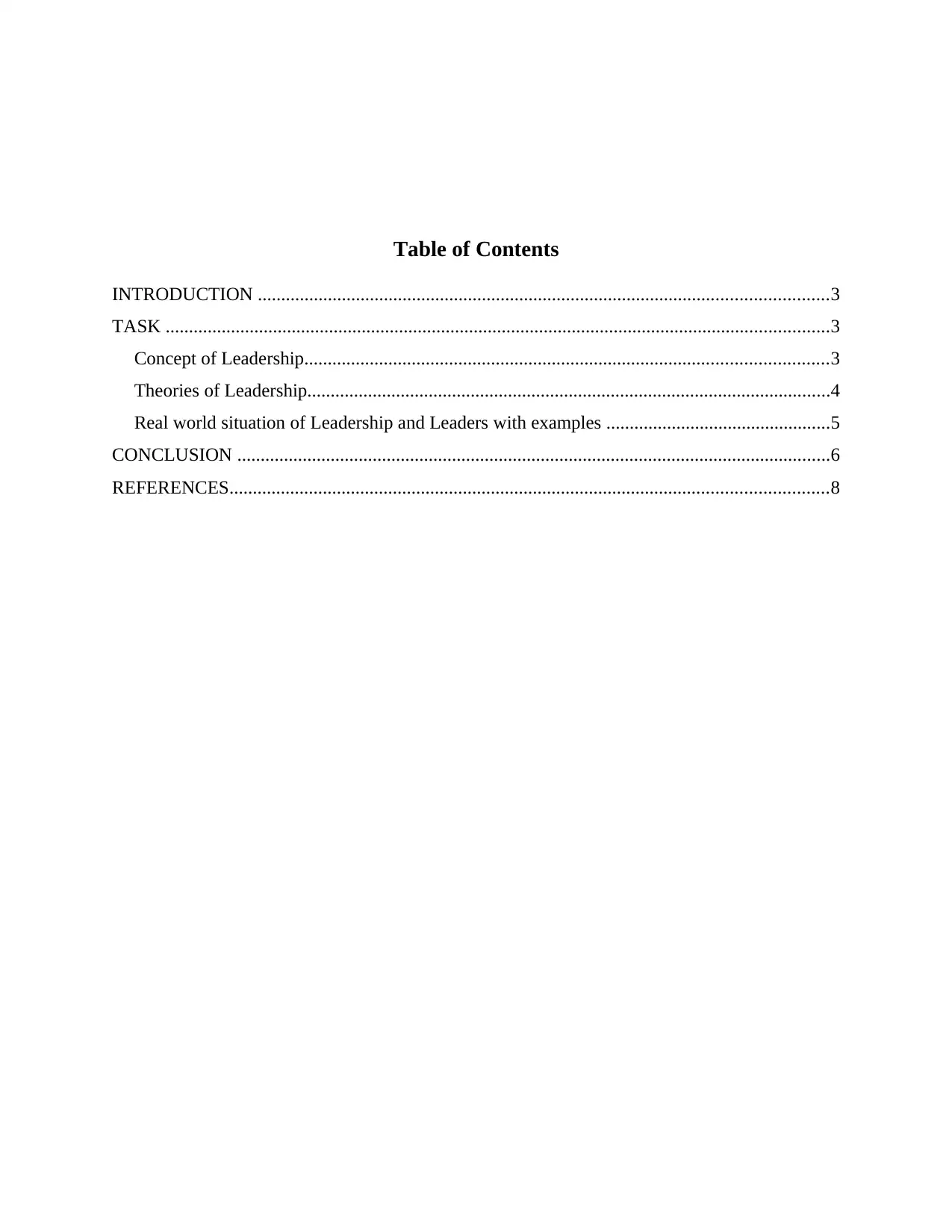
Table of Contents
INTRODUCTION ..........................................................................................................................3
TASK ..............................................................................................................................................3
Concept of Leadership................................................................................................................3
Theories of Leadership................................................................................................................4
Real world situation of Leadership and Leaders with examples ................................................5
CONCLUSION ...............................................................................................................................6
REFERENCES................................................................................................................................8
INTRODUCTION ..........................................................................................................................3
TASK ..............................................................................................................................................3
Concept of Leadership................................................................................................................3
Theories of Leadership................................................................................................................4
Real world situation of Leadership and Leaders with examples ................................................5
CONCLUSION ...............................................................................................................................6
REFERENCES................................................................................................................................8
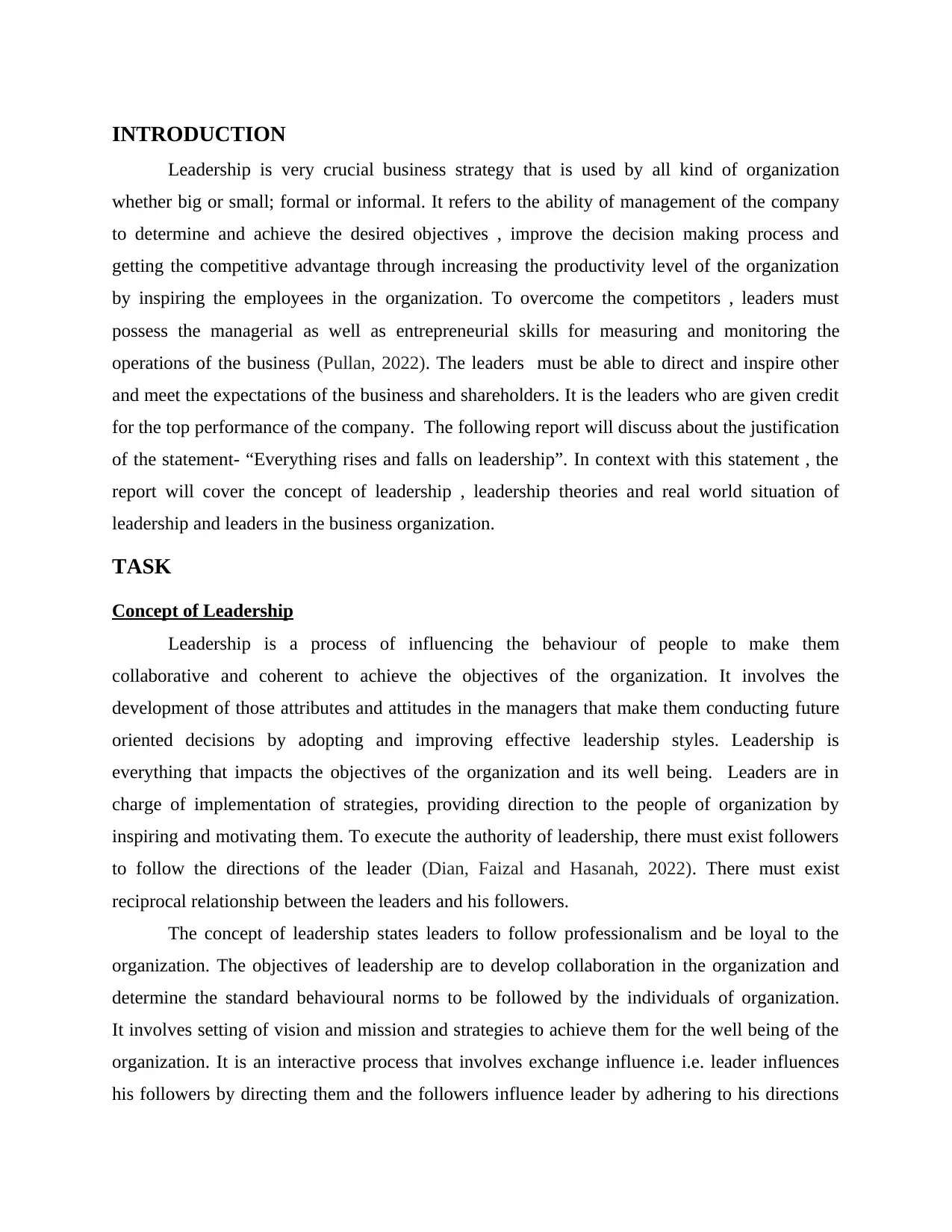
INTRODUCTION
Leadership is very crucial business strategy that is used by all kind of organization
whether big or small; formal or informal. It refers to the ability of management of the company
to determine and achieve the desired objectives , improve the decision making process and
getting the competitive advantage through increasing the productivity level of the organization
by inspiring the employees in the organization. To overcome the competitors , leaders must
possess the managerial as well as entrepreneurial skills for measuring and monitoring the
operations of the business (Pullan, 2022). The leaders must be able to direct and inspire other
and meet the expectations of the business and shareholders. It is the leaders who are given credit
for the top performance of the company. The following report will discuss about the justification
of the statement- “Everything rises and falls on leadership”. In context with this statement , the
report will cover the concept of leadership , leadership theories and real world situation of
leadership and leaders in the business organization.
TASK
Concept of Leadership
Leadership is a process of influencing the behaviour of people to make them
collaborative and coherent to achieve the objectives of the organization. It involves the
development of those attributes and attitudes in the managers that make them conducting future
oriented decisions by adopting and improving effective leadership styles. Leadership is
everything that impacts the objectives of the organization and its well being. Leaders are in
charge of implementation of strategies, providing direction to the people of organization by
inspiring and motivating them. To execute the authority of leadership, there must exist followers
to follow the directions of the leader (Dian, Faizal and Hasanah, 2022). There must exist
reciprocal relationship between the leaders and his followers.
The concept of leadership states leaders to follow professionalism and be loyal to the
organization. The objectives of leadership are to develop collaboration in the organization and
determine the standard behavioural norms to be followed by the individuals of organization.
It involves setting of vision and mission and strategies to achieve them for the well being of the
organization. It is an interactive process that involves exchange influence i.e. leader influences
his followers by directing them and the followers influence leader by adhering to his directions
Leadership is very crucial business strategy that is used by all kind of organization
whether big or small; formal or informal. It refers to the ability of management of the company
to determine and achieve the desired objectives , improve the decision making process and
getting the competitive advantage through increasing the productivity level of the organization
by inspiring the employees in the organization. To overcome the competitors , leaders must
possess the managerial as well as entrepreneurial skills for measuring and monitoring the
operations of the business (Pullan, 2022). The leaders must be able to direct and inspire other
and meet the expectations of the business and shareholders. It is the leaders who are given credit
for the top performance of the company. The following report will discuss about the justification
of the statement- “Everything rises and falls on leadership”. In context with this statement , the
report will cover the concept of leadership , leadership theories and real world situation of
leadership and leaders in the business organization.
TASK
Concept of Leadership
Leadership is a process of influencing the behaviour of people to make them
collaborative and coherent to achieve the objectives of the organization. It involves the
development of those attributes and attitudes in the managers that make them conducting future
oriented decisions by adopting and improving effective leadership styles. Leadership is
everything that impacts the objectives of the organization and its well being. Leaders are in
charge of implementation of strategies, providing direction to the people of organization by
inspiring and motivating them. To execute the authority of leadership, there must exist followers
to follow the directions of the leader (Dian, Faizal and Hasanah, 2022). There must exist
reciprocal relationship between the leaders and his followers.
The concept of leadership states leaders to follow professionalism and be loyal to the
organization. The objectives of leadership are to develop collaboration in the organization and
determine the standard behavioural norms to be followed by the individuals of organization.
It involves setting of vision and mission and strategies to achieve them for the well being of the
organization. It is an interactive process that involves exchange influence i.e. leader influences
his followers by directing them and the followers influence leader by adhering to his directions
⊘ This is a preview!⊘
Do you want full access?
Subscribe today to unlock all pages.

Trusted by 1+ million students worldwide
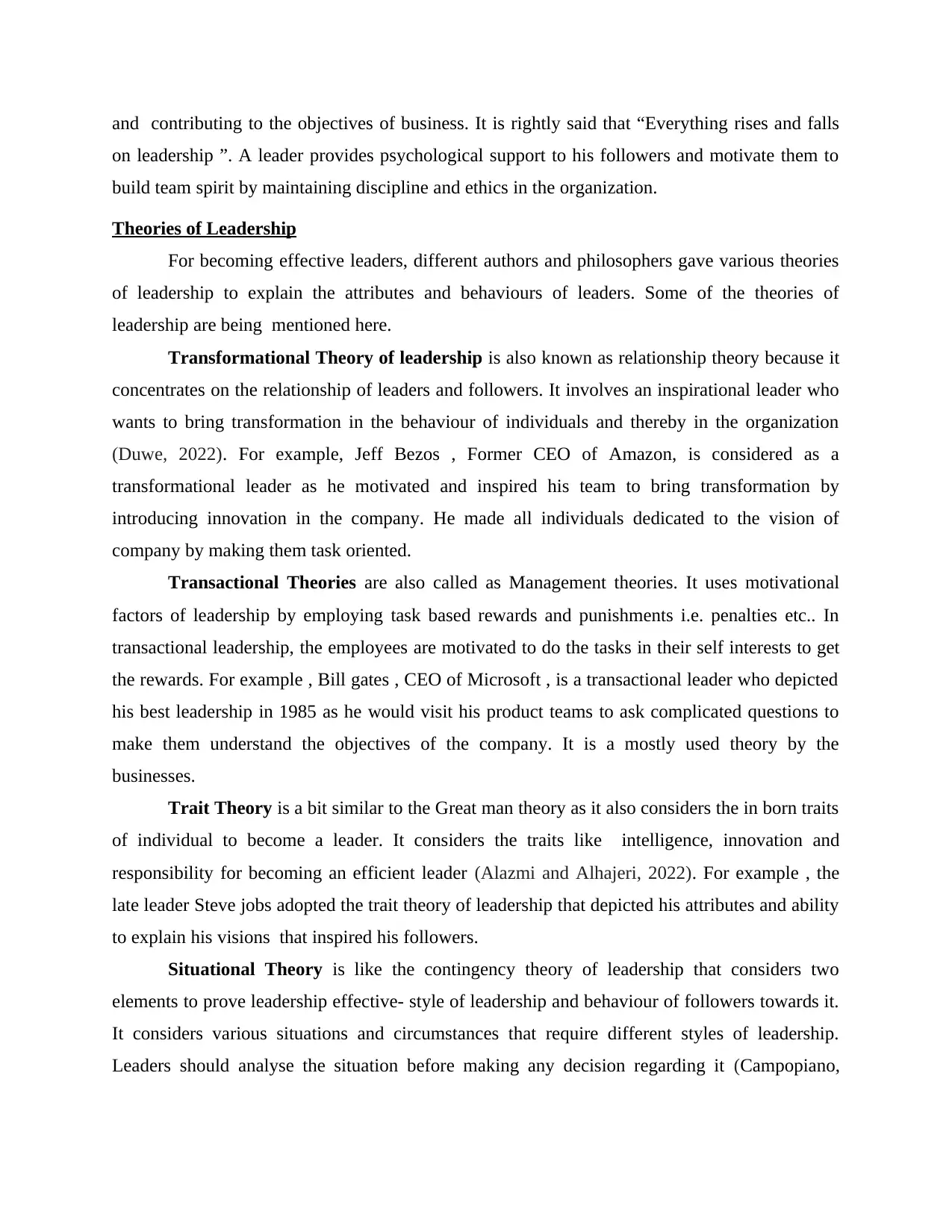
and contributing to the objectives of business. It is rightly said that “Everything rises and falls
on leadership ”. A leader provides psychological support to his followers and motivate them to
build team spirit by maintaining discipline and ethics in the organization.
Theories of Leadership
For becoming effective leaders, different authors and philosophers gave various theories
of leadership to explain the attributes and behaviours of leaders. Some of the theories of
leadership are being mentioned here.
Transformational Theory of leadership is also known as relationship theory because it
concentrates on the relationship of leaders and followers. It involves an inspirational leader who
wants to bring transformation in the behaviour of individuals and thereby in the organization
(Duwe, 2022). For example, Jeff Bezos , Former CEO of Amazon, is considered as a
transformational leader as he motivated and inspired his team to bring transformation by
introducing innovation in the company. He made all individuals dedicated to the vision of
company by making them task oriented.
Transactional Theories are also called as Management theories. It uses motivational
factors of leadership by employing task based rewards and punishments i.e. penalties etc.. In
transactional leadership, the employees are motivated to do the tasks in their self interests to get
the rewards. For example , Bill gates , CEO of Microsoft , is a transactional leader who depicted
his best leadership in 1985 as he would visit his product teams to ask complicated questions to
make them understand the objectives of the company. It is a mostly used theory by the
businesses.
Trait Theory is a bit similar to the Great man theory as it also considers the in born traits
of individual to become a leader. It considers the traits like intelligence, innovation and
responsibility for becoming an efficient leader (Alazmi and Alhajeri, 2022). For example , the
late leader Steve jobs adopted the trait theory of leadership that depicted his attributes and ability
to explain his visions that inspired his followers.
Situational Theory is like the contingency theory of leadership that considers two
elements to prove leadership effective- style of leadership and behaviour of followers towards it.
It considers various situations and circumstances that require different styles of leadership.
Leaders should analyse the situation before making any decision regarding it (Campopiano,
on leadership ”. A leader provides psychological support to his followers and motivate them to
build team spirit by maintaining discipline and ethics in the organization.
Theories of Leadership
For becoming effective leaders, different authors and philosophers gave various theories
of leadership to explain the attributes and behaviours of leaders. Some of the theories of
leadership are being mentioned here.
Transformational Theory of leadership is also known as relationship theory because it
concentrates on the relationship of leaders and followers. It involves an inspirational leader who
wants to bring transformation in the behaviour of individuals and thereby in the organization
(Duwe, 2022). For example, Jeff Bezos , Former CEO of Amazon, is considered as a
transformational leader as he motivated and inspired his team to bring transformation by
introducing innovation in the company. He made all individuals dedicated to the vision of
company by making them task oriented.
Transactional Theories are also called as Management theories. It uses motivational
factors of leadership by employing task based rewards and punishments i.e. penalties etc.. In
transactional leadership, the employees are motivated to do the tasks in their self interests to get
the rewards. For example , Bill gates , CEO of Microsoft , is a transactional leader who depicted
his best leadership in 1985 as he would visit his product teams to ask complicated questions to
make them understand the objectives of the company. It is a mostly used theory by the
businesses.
Trait Theory is a bit similar to the Great man theory as it also considers the in born traits
of individual to become a leader. It considers the traits like intelligence, innovation and
responsibility for becoming an efficient leader (Alazmi and Alhajeri, 2022). For example , the
late leader Steve jobs adopted the trait theory of leadership that depicted his attributes and ability
to explain his visions that inspired his followers.
Situational Theory is like the contingency theory of leadership that considers two
elements to prove leadership effective- style of leadership and behaviour of followers towards it.
It considers various situations and circumstances that require different styles of leadership.
Leaders should analyse the situation before making any decision regarding it (Campopiano,
Paraphrase This Document
Need a fresh take? Get an instant paraphrase of this document with our AI Paraphraser
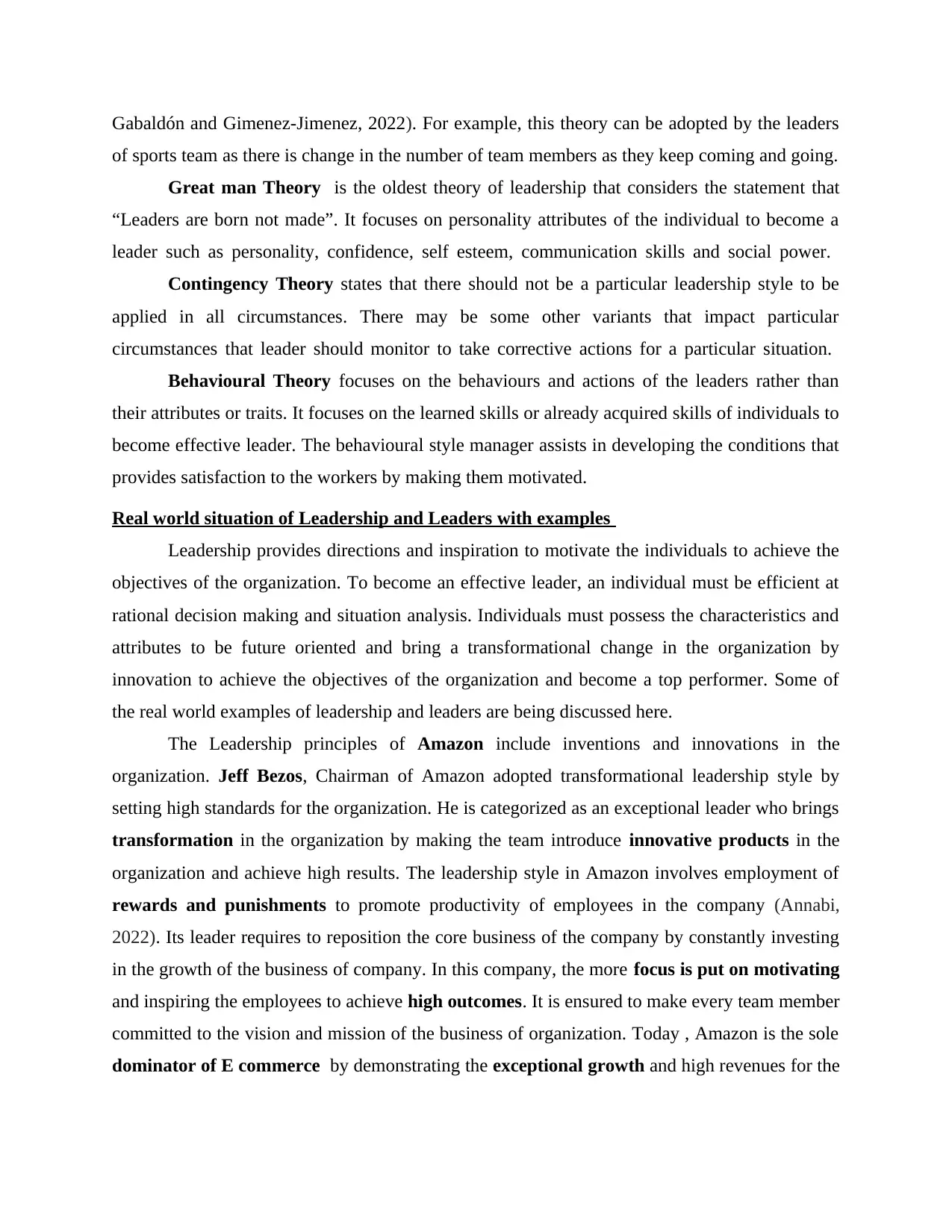
Gabaldón and Gimenez-Jimenez, 2022). For example, this theory can be adopted by the leaders
of sports team as there is change in the number of team members as they keep coming and going.
Great man Theory is the oldest theory of leadership that considers the statement that
“Leaders are born not made”. It focuses on personality attributes of the individual to become a
leader such as personality, confidence, self esteem, communication skills and social power.
Contingency Theory states that there should not be a particular leadership style to be
applied in all circumstances. There may be some other variants that impact particular
circumstances that leader should monitor to take corrective actions for a particular situation.
Behavioural Theory focuses on the behaviours and actions of the leaders rather than
their attributes or traits. It focuses on the learned skills or already acquired skills of individuals to
become effective leader. The behavioural style manager assists in developing the conditions that
provides satisfaction to the workers by making them motivated.
Real world situation of Leadership and Leaders with examples
Leadership provides directions and inspiration to motivate the individuals to achieve the
objectives of the organization. To become an effective leader, an individual must be efficient at
rational decision making and situation analysis. Individuals must possess the characteristics and
attributes to be future oriented and bring a transformational change in the organization by
innovation to achieve the objectives of the organization and become a top performer. Some of
the real world examples of leadership and leaders are being discussed here.
The Leadership principles of Amazon include inventions and innovations in the
organization. Jeff Bezos, Chairman of Amazon adopted transformational leadership style by
setting high standards for the organization. He is categorized as an exceptional leader who brings
transformation in the organization by making the team introduce innovative products in the
organization and achieve high results. The leadership style in Amazon involves employment of
rewards and punishments to promote productivity of employees in the company (Annabi,
2022). Its leader requires to reposition the core business of the company by constantly investing
in the growth of the business of company. In this company, the more focus is put on motivating
and inspiring the employees to achieve high outcomes. It is ensured to make every team member
committed to the vision and mission of the business of organization. Today , Amazon is the sole
dominator of E commerce by demonstrating the exceptional growth and high revenues for the
of sports team as there is change in the number of team members as they keep coming and going.
Great man Theory is the oldest theory of leadership that considers the statement that
“Leaders are born not made”. It focuses on personality attributes of the individual to become a
leader such as personality, confidence, self esteem, communication skills and social power.
Contingency Theory states that there should not be a particular leadership style to be
applied in all circumstances. There may be some other variants that impact particular
circumstances that leader should monitor to take corrective actions for a particular situation.
Behavioural Theory focuses on the behaviours and actions of the leaders rather than
their attributes or traits. It focuses on the learned skills or already acquired skills of individuals to
become effective leader. The behavioural style manager assists in developing the conditions that
provides satisfaction to the workers by making them motivated.
Real world situation of Leadership and Leaders with examples
Leadership provides directions and inspiration to motivate the individuals to achieve the
objectives of the organization. To become an effective leader, an individual must be efficient at
rational decision making and situation analysis. Individuals must possess the characteristics and
attributes to be future oriented and bring a transformational change in the organization by
innovation to achieve the objectives of the organization and become a top performer. Some of
the real world examples of leadership and leaders are being discussed here.
The Leadership principles of Amazon include inventions and innovations in the
organization. Jeff Bezos, Chairman of Amazon adopted transformational leadership style by
setting high standards for the organization. He is categorized as an exceptional leader who brings
transformation in the organization by making the team introduce innovative products in the
organization and achieve high results. The leadership style in Amazon involves employment of
rewards and punishments to promote productivity of employees in the company (Annabi,
2022). Its leader requires to reposition the core business of the company by constantly investing
in the growth of the business of company. In this company, the more focus is put on motivating
and inspiring the employees to achieve high outcomes. It is ensured to make every team member
committed to the vision and mission of the business of organization. Today , Amazon is the sole
dominator of E commerce by demonstrating the exceptional growth and high revenues for the
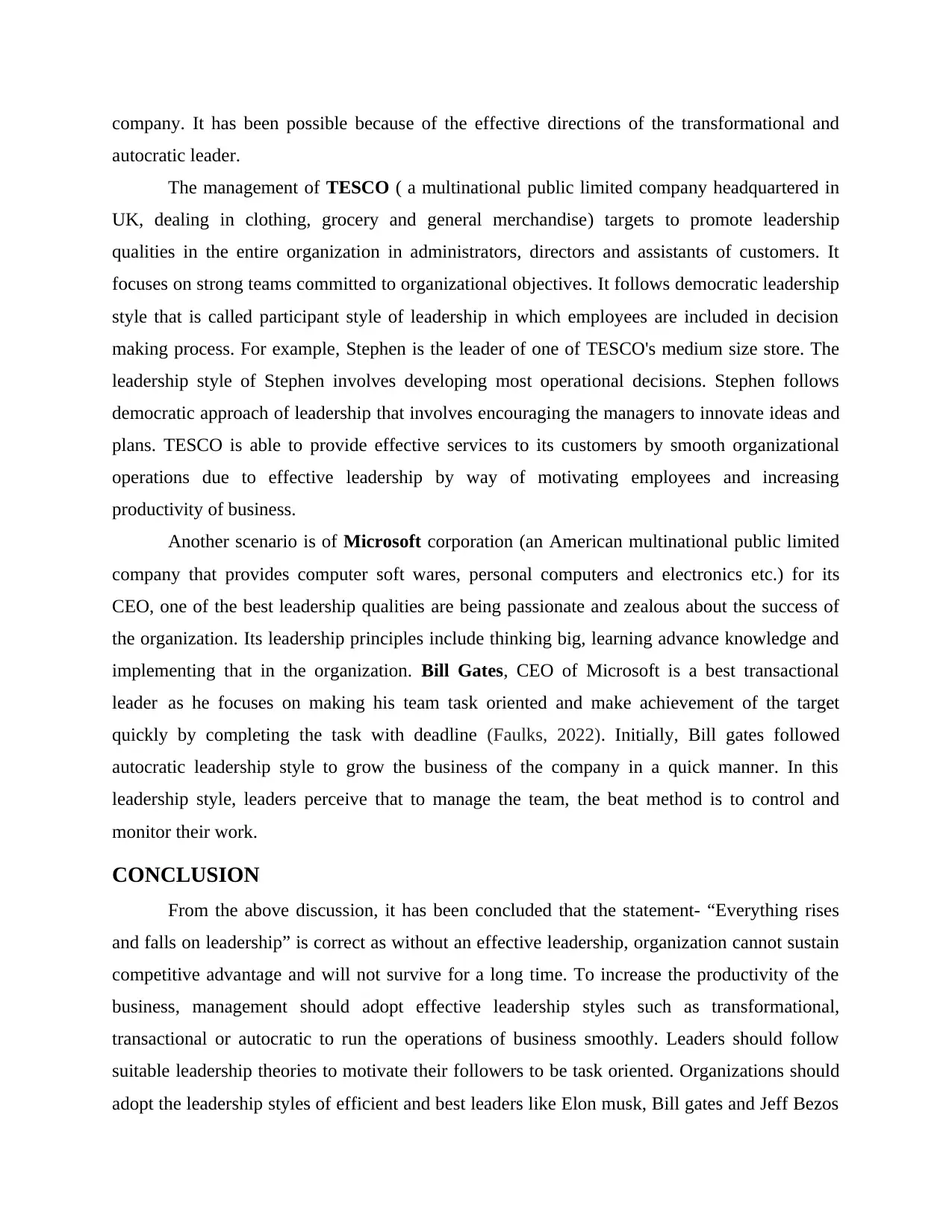
company. It has been possible because of the effective directions of the transformational and
autocratic leader.
The management of TESCO ( a multinational public limited company headquartered in
UK, dealing in clothing, grocery and general merchandise) targets to promote leadership
qualities in the entire organization in administrators, directors and assistants of customers. It
focuses on strong teams committed to organizational objectives. It follows democratic leadership
style that is called participant style of leadership in which employees are included in decision
making process. For example, Stephen is the leader of one of TESCO's medium size store. The
leadership style of Stephen involves developing most operational decisions. Stephen follows
democratic approach of leadership that involves encouraging the managers to innovate ideas and
plans. TESCO is able to provide effective services to its customers by smooth organizational
operations due to effective leadership by way of motivating employees and increasing
productivity of business.
Another scenario is of Microsoft corporation (an American multinational public limited
company that provides computer soft wares, personal computers and electronics etc.) for its
CEO, one of the best leadership qualities are being passionate and zealous about the success of
the organization. Its leadership principles include thinking big, learning advance knowledge and
implementing that in the organization. Bill Gates, CEO of Microsoft is a best transactional
leader as he focuses on making his team task oriented and make achievement of the target
quickly by completing the task with deadline (Faulks, 2022). Initially, Bill gates followed
autocratic leadership style to grow the business of the company in a quick manner. In this
leadership style, leaders perceive that to manage the team, the beat method is to control and
monitor their work.
CONCLUSION
From the above discussion, it has been concluded that the statement- “Everything rises
and falls on leadership” is correct as without an effective leadership, organization cannot sustain
competitive advantage and will not survive for a long time. To increase the productivity of the
business, management should adopt effective leadership styles such as transformational,
transactional or autocratic to run the operations of business smoothly. Leaders should follow
suitable leadership theories to motivate their followers to be task oriented. Organizations should
adopt the leadership styles of efficient and best leaders like Elon musk, Bill gates and Jeff Bezos
autocratic leader.
The management of TESCO ( a multinational public limited company headquartered in
UK, dealing in clothing, grocery and general merchandise) targets to promote leadership
qualities in the entire organization in administrators, directors and assistants of customers. It
focuses on strong teams committed to organizational objectives. It follows democratic leadership
style that is called participant style of leadership in which employees are included in decision
making process. For example, Stephen is the leader of one of TESCO's medium size store. The
leadership style of Stephen involves developing most operational decisions. Stephen follows
democratic approach of leadership that involves encouraging the managers to innovate ideas and
plans. TESCO is able to provide effective services to its customers by smooth organizational
operations due to effective leadership by way of motivating employees and increasing
productivity of business.
Another scenario is of Microsoft corporation (an American multinational public limited
company that provides computer soft wares, personal computers and electronics etc.) for its
CEO, one of the best leadership qualities are being passionate and zealous about the success of
the organization. Its leadership principles include thinking big, learning advance knowledge and
implementing that in the organization. Bill Gates, CEO of Microsoft is a best transactional
leader as he focuses on making his team task oriented and make achievement of the target
quickly by completing the task with deadline (Faulks, 2022). Initially, Bill gates followed
autocratic leadership style to grow the business of the company in a quick manner. In this
leadership style, leaders perceive that to manage the team, the beat method is to control and
monitor their work.
CONCLUSION
From the above discussion, it has been concluded that the statement- “Everything rises
and falls on leadership” is correct as without an effective leadership, organization cannot sustain
competitive advantage and will not survive for a long time. To increase the productivity of the
business, management should adopt effective leadership styles such as transformational,
transactional or autocratic to run the operations of business smoothly. Leaders should follow
suitable leadership theories to motivate their followers to be task oriented. Organizations should
adopt the leadership styles of efficient and best leaders like Elon musk, Bill gates and Jeff Bezos
⊘ This is a preview!⊘
Do you want full access?
Subscribe today to unlock all pages.

Trusted by 1+ million students worldwide

to promote growth of the organization in an effective way and become the top performer in the
market.
market.
Paraphrase This Document
Need a fresh take? Get an instant paraphrase of this document with our AI Paraphraser
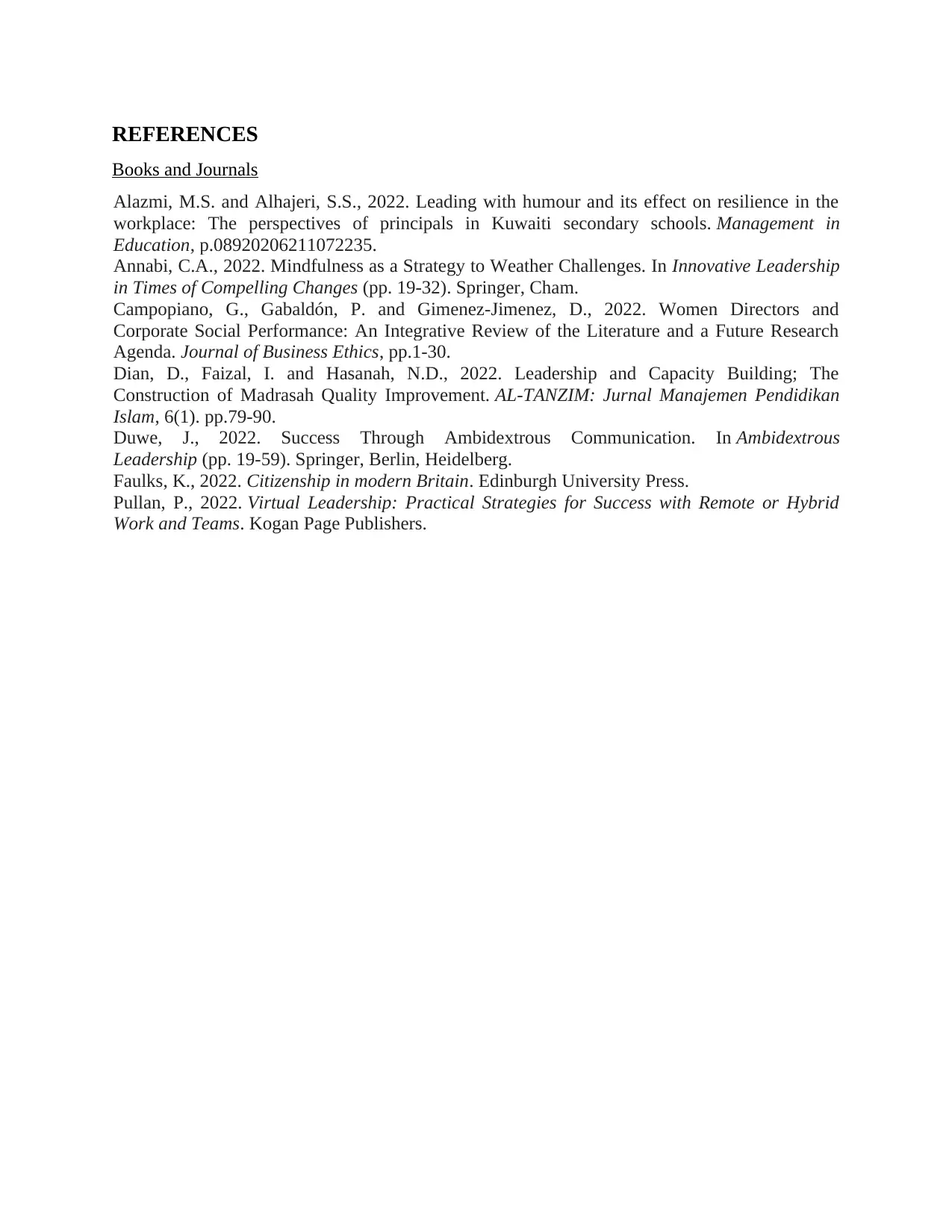
REFERENCES
Books and Journals
Alazmi, M.S. and Alhajeri, S.S., 2022. Leading with humour and its effect on resilience in the
workplace: The perspectives of principals in Kuwaiti secondary schools. Management in
Education, p.08920206211072235.
Annabi, C.A., 2022. Mindfulness as a Strategy to Weather Challenges. In Innovative Leadership
in Times of Compelling Changes (pp. 19-32). Springer, Cham.
Campopiano, G., Gabaldón, P. and Gimenez-Jimenez, D., 2022. Women Directors and
Corporate Social Performance: An Integrative Review of the Literature and a Future Research
Agenda. Journal of Business Ethics, pp.1-30.
Dian, D., Faizal, I. and Hasanah, N.D., 2022. Leadership and Capacity Building; The
Construction of Madrasah Quality Improvement. AL-TANZIM: Jurnal Manajemen Pendidikan
Islam, 6(1). pp.79-90.
Duwe, J., 2022. Success Through Ambidextrous Communication. In Ambidextrous
Leadership (pp. 19-59). Springer, Berlin, Heidelberg.
Faulks, K., 2022. Citizenship in modern Britain. Edinburgh University Press.
Pullan, P., 2022. Virtual Leadership: Practical Strategies for Success with Remote or Hybrid
Work and Teams. Kogan Page Publishers.
Books and Journals
Alazmi, M.S. and Alhajeri, S.S., 2022. Leading with humour and its effect on resilience in the
workplace: The perspectives of principals in Kuwaiti secondary schools. Management in
Education, p.08920206211072235.
Annabi, C.A., 2022. Mindfulness as a Strategy to Weather Challenges. In Innovative Leadership
in Times of Compelling Changes (pp. 19-32). Springer, Cham.
Campopiano, G., Gabaldón, P. and Gimenez-Jimenez, D., 2022. Women Directors and
Corporate Social Performance: An Integrative Review of the Literature and a Future Research
Agenda. Journal of Business Ethics, pp.1-30.
Dian, D., Faizal, I. and Hasanah, N.D., 2022. Leadership and Capacity Building; The
Construction of Madrasah Quality Improvement. AL-TANZIM: Jurnal Manajemen Pendidikan
Islam, 6(1). pp.79-90.
Duwe, J., 2022. Success Through Ambidextrous Communication. In Ambidextrous
Leadership (pp. 19-59). Springer, Berlin, Heidelberg.
Faulks, K., 2022. Citizenship in modern Britain. Edinburgh University Press.
Pullan, P., 2022. Virtual Leadership: Practical Strategies for Success with Remote or Hybrid
Work and Teams. Kogan Page Publishers.
1 out of 8
Related Documents
Your All-in-One AI-Powered Toolkit for Academic Success.
+13062052269
info@desklib.com
Available 24*7 on WhatsApp / Email
![[object Object]](/_next/static/media/star-bottom.7253800d.svg)
Unlock your academic potential
Copyright © 2020–2025 A2Z Services. All Rights Reserved. Developed and managed by ZUCOL.



